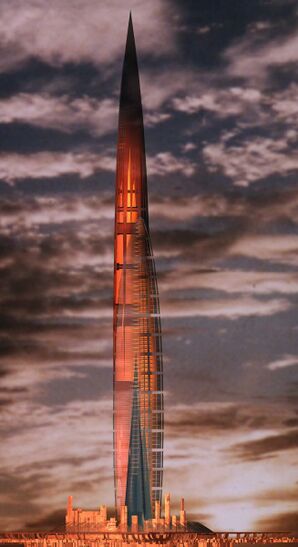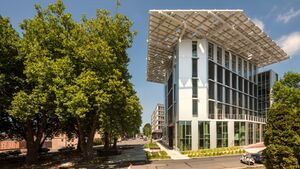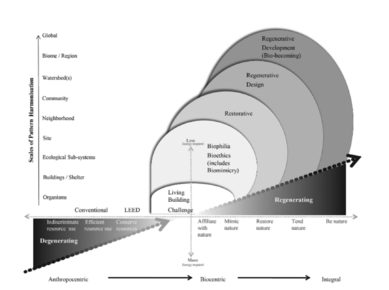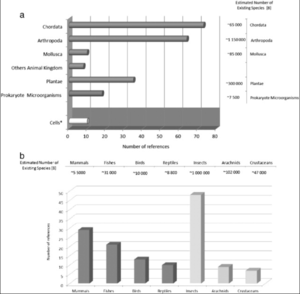Course:CONS200/2020/Biomimicry in urban design: the key to urban biodiversity conservation?

Biomimicry is an engineering technology that study structure, function and working principle of organisms, and then transplant these principles to scientific research.[1] Invent instruments, devices and machines with superior performance and create new technologies. From the birth and development of biomimicry, to just a few decades now, its research results have been very impressive. The advent of biomimicry has opened up a unique technological development path, that is, the way to obtain blueprints from the biological world. It has greatly broadened people's horizons and displayed extremely strong vitality. There are many interesting inventions created by biomimicry. For example, according to the ability of recognizing colors by the human eye, scientists have invented a machine that recognizes the quality of apples for the classification, and scientists invented a drilling machine that can automatically replace the drill bit by studying the hadrosaurs's teeth[2]. Human beings are facing intensified environmental problems and biodiversity reduction. In order to alleviate and solve such problems, human beings have used various methods, biomimetic technology is one of them. Biomimicry can be a powerful design tool if well thought out in the context of clear environmental sustainability performance goals.[3]How designers use bionics in urban design? Whether bionics is effective in protecting biodiversity?Is it the key to protecting biodiversity in urban design?
Urban Biodiversity
Urban biodiversity refers to various organisms found in urban ecosystems, and is usually reduced by the number of species (and their richness) found in a given city or urban area. The term also includes genetic diversity (for example, some cities may have local indigenous varieties) and ecosystem diversity (including the different types of habitats and communities found in cities). In addition to biogeographic factors, urban biodiversity is also affected by human factors (for example, the impact of climate change on urban biodiversity mainly through city-specific factors. [4]
Important of biodiversity in city
The impact of biodiversity on people in cities:
The impact of biodiversity on people work out similar way as people impact biodiversity. The biodiversity loss impact people in many way like increased climate changes, decreased resilience to changes, and reduced quality or quantity of ecosystem services. Studies have shown that urban biodiversity has obvious effects: human physical health, human mental health, social and cultural health, and The economy is healthy and stable.[5]
Recent studies have shown that if critical thresholds are exceeded in ecosystems, biodiversity loss and certain ecosystem services may collapse, and the impact on humans may be severe, which may include widespread social unrest, economic unrest, and extensive loss of life.[6]Therefore, protecting urban biodiversity is crucial.
Biomimicry
Definition of Biomimicry:
Increasing of population and regulation are forcing human to consider about environmental sustainability when we used the resources. Since the impact of climate change and other environmental issues became significant, in the past few years the objectives of human or businesses have shift to green product innovation. Biomimicry is one of the eco-design tools that is green product innovation also can be sustainable development. Biomimicry can be simply defined as apply the biological processes, patterns to our technology and it will make this new technology environmentally friendly and sustainable. Biomimicry was used on many things that around us, from a single building to an aircraft. Human is learning the successful of animal’s structure and use it on our technology and it works out very well. For example, The Bullet Train (500 Series Shinkansen) in Japan provides a higher speed, faster service to attract people use community transportation instead of driving own car in order to reduce the pollution. Also, the bird-like shape of the train can reduce the noise when train pass through the tunnel. There is more example around us that we can find out during our daily life as increasing of energy demand in the future the biomimicry product will become more important to environment sustainability.[3]
Three main components:
Bionic functions:
Bionic functions is apply how biologic functions into our technology. As human start to learned about the structure of animal and how animal's body functions we finds out that we can apply them in order to improve our technology.
Bionic structures:

In China, they are planning to build a “Bionic Tower” in Shanghai. The tower will be the tallest building in the world at 300 floors. The design that use of biomimicry not just the building itself, the foundation is Inspired by the biological structure as well. The design team use the new widespread network of anchorage that is similar to tree roots instead of the traditional foundation. The new widespread network could increase the ability of building to against the extreme natural disaster like earthquake and strong wind. Also, due to the strong new foundation system the building can provides a large living space on the small amount of land required just about (166 m x 133 m). This could be helpful to the conservation of biodiversity in our modern world since we don’t need to develop more land because of population expansion and destroyed the natural habitat of the wild living animals.[7]
Bionic building materials:

Due to global warming the temperatures around the world increase significantly around the world. Air conditioner is the first thing that we think could cool the building or house down. However, it could only make the case worse because air conditioner is one of the reasons that cause global warming. Prvin Bhiwapurkar, a professor of architecture at University of Cincinnati and biologist Daphne Fecheyr- Lippens took the idea from two heat and humidity resilient animals which is the African reed frog and the Hercules beetle, both species are able to change their skin layer corresponding to the temperature and humidity changes. Bhiwapurkar and Fecheyr-Lippens finds out around 66 percent of air-conditioning energy can be save if the building were outfitted with a heat reflecting exterior like African reed frog and the Hercules beetle.[8]

Biomimicry in urban design
Biomimicry is the key to urban biodiversity
Bionics is multidisciplinary cooperation and multidisciplinary technology. Bionics has been widely accepted since Janine Benyus proposed it in 1997.[9] With the advent of 2000, the human world entered the fourth industrial revolution.[10] Bionics has attracted worldwide attention because it imitates and defines natural structures and functions to achieve sustainable development.[11]
In recent years, bionics has been widely used in various fields. Especially in urban design, it becomes particularly important. “A synergistic response: ecological regeneration through urban design” is the idea that came up by Pedersen in 2018.[12] The idea is to combine different design concepts to achieve a neutral impact on the environment while building the city.[12] As shown in Figure 1. Through the bionics design to achieve the purpose of urban sustainability, the city will eventually be built into an ecosystem that is similar to nature, in such a situation to maintain the maximum ecological diversity. And finally, achieve the purpose of protecting urban biodiversity.

It is worth mentioning that when bionics supports urban biodiversity, biodiversity will also inspire innovation in bionics.[13] The data research illustrates the development of biodiversity that inspires bionics. The figure shows the most inspiring species for various applications.[13] As shown in Figure 2.
Practical application
Bionics has been practically applied in urban design and has made efforts to increase urban biodiversity. In the are of dynamic optical materials,[13] there is an example like nature engineers took inspiration from the UV reflective strands of spider webs and created a bird-safe glass. In nature, birds can see identify these reflective strands and avoid them. [14] Because each year 100 million birds die every year after crashing into glass windows, doors and so on.[14] For Birds, it's almost impossible to identify the transparent surface of the glass.[14] This can a real example that how biomimicry is used in urban design to protect urban biodiversity conservation.[14]
Advantages of Biomimicry urban design
With the idea of Biomimicry urban design, there are various advantages we can get.
- Multi-functional products. In nature, there are no objects born for a single purpose. Like the leaves from trees, they provide shades and energy, and bark, which also help to protect and cool the water beneath the surface.[15]
- Enhance the ecosystem services. Buildings, streets, infrastructures and parks can be built as a whole system just like the natural ecosystem does: storm water harvest; flood mitigation; habitat creation; energy production; and carbon sequestration.[15]
- Embody resilience. Creatures on earth are adapting and changing to fit the natural environment over billion years. By studying how other species confers resilience on its systems, we can construct man-made systems with inherent resilience.[15]
- Greener, lighter, and smarter. This type of design can save resources and energy, reduce the load and pollution of the building on the environment, and use efficient and energy-saving architectural design schemes and advanced technologies that can promote the virtuous cycle of the ecosystem and facilitate environmental self-protection, so as to finally reach a human. The goal of sustainable development in harmony with nature.[15]
- Aesthetic. Using different colors, constructions and shapes in nature to decorate the interior, let the elements from nature stimulate the human vision, and cause people to strongly reflect. So that natural beauty, harmony beauty, and personality beauty are perfectly displayed into modern interior decoration. Unify the elements of nature to create a feeling of "return to nature".[15]
Future concerns
High technology requirement:
The technology and knowledge required for bionic design are rarely accessible to existing architectural designers. Even scientific researchers are still building the theoretical foundation. So before we can actually use bionic design on a large scale, we still need a lot of technology and theory to develop. Another question is whether the green concept of bionic design can be accepted by the public. Most North American families currently prefer single family house with a private garden.It need time to transform their ideas and accept the bionic design.
High economic cost:
The technology and knowledge required for bionic design are rarely accessible to existing architectural designers. Even scientific researchers are still building the theoretical foundation. So before we can actually use bionic design on a large scale, we still need a lot of technology and theory to develop. Another question is whether the green concept of bionic design can be accepted by the public. Most North American families currently prefer single family house with a private garden.It need time to transform their ideas and accept the bionic design.
Summary
In the coming decades, people will face a wide range of changes, and the task of protecting biodiversity will be more arduous. The application of bionics will be considerable in the future and the bionic technology will be innovative.Humans could respond to ecosystem degradation and biodiversity loss by simulating or mimicking ecosystem as part of regenerative design. Designers build the built environment to restore the function of ecosystem and its ability of healthy development, so that people would solve the problem of continuous degradation of biodiversity.[16]
References
- ↑ The Oxford dictionary. Oxford University Press. 1992.
- ↑ Aaron R. H. LeBlanc et al. Ontogeny reveals function and evolution of the hadrosaurid dinosaur dental battery, BMC Evolutionary Biology (2016). DOI: 10.1186/s12862-016-0721-1
- ↑ 3.0 3.1 Kennedy, E. B., & Marting, T. A. (2016). Biomimicry: Streamlining the front end of innovation for environmentally sustainable products: Biomimicry can be a powerful design tool to support sustainability-driven product development in the front end of innovation. Research-Technology Management, 59(4), 40-48. doi:10.1080/08956308.2016.1185342
- ↑ Puppim de Oliveira J.A., Doll C.N.H., Moreno-Peñaranda R., Balaban O. (2014) Urban Biodiversity and Climate Change. In: Freedman B. (eds) Global Environmental Change. Handbook of Global Environmental Pollution, vol 1. Springer, Dordrecht
- ↑ Zari, M.P. (2018). The importance of urban biodiversity – an ecosystem services approach. Biodiversity Int J. 2018;2(4):357-360. DOI: 10.15406/bij.2018.02.00087 Retrieved from https://medcraveonline.com/BIJ/the-importance-of-urban-biodiversity-ndash-an-ecosystem-services-approach.html#ref13
- ↑ Barnosky, A., E. Hadly, J. Bascompte, E. Berlow, et al. (2012). Approaching a state shift in Earth's biosphere. Nature 486(7401): 52-58.
- ↑ Wegner, C., Minnaert, L., Ohlberger, S., & Pulka, S. (2017, June 12). Science in School . Retrieved from Bionic Structures: from stalks to skyscrapers : https://www.scienceinschool.org/content/bionic-structures-stalks-skyscrapers
- ↑ Hu, J. C. (2019, Sep 6). These self-cooled buildings were inspired by termites and frogs. Retrieved from grist: https://grist.org/article/these-self-cooled-buildings-were-inspired-by-termites-and-frogs/
- ↑ Benyus, J. M. (1997). Biomimicry: innovation inspired by nature. William Morrow, New York, New York, USA.
- ↑ Herweijer, C., and B. Combes. (2017). Innovation for the Earth: harnessing technological breakthroughs for people and the planet. Pages 1–29 in World Economic Forum, January 2017, Davos, Switzerland.
- ↑ Kennedy, E., D. Fecheyr‐Lippens, B.‐K. Hsiung, P. H. Niewiarowski, and M. Kolodziej. (2015). Biomimicry: a path to sustainable innovation. Design Issues 31:66–73.
- ↑ 12.0 12.1 Pedersen Zari, M. (2018). Regenerative Urban Design and Ecosystem Biomimicry. London: Routledge, https://doi-org.ezproxy.library.ubc.ca/10.4324/9781315114330
- ↑ 13.0 13.1 13.2 Elena, L. L. (2014). Product and technology innovation: What can biomimicry inspire? Biotechnology Advances. 32. 8. pp, 1494-1505. Retrieved from: https://www-sciencedirect-com.ezproxy.library.ubc.ca/science/article/pii/S0734975014001517?via%3Dihub
- ↑ 14.0 14.1 14.2 14.3 Donovan, A. (2018). Biomimicry: 9 Ways Engineers Have Been 'Inspired' by Nature. Retrieved from: https://interestingengineering.com/biomimicry-9-ways-engineers-have-been-inspired-by-nature
- ↑ 15.0 15.1 15.2 15.3 15.4 Phillips, Amy (2015). "9 benefits of blending biomimicry and the built environment". GreenBiz.
- ↑ Zari, M. P. (2018). Regenerative urban design and ecosystem biomimicry (1st ed.) Routledge Ltd. doi:10.4324/9781315114330
| This conservation resource was created by Course:CONS200. It is shared under a CC-BY 4.0 International License. |
